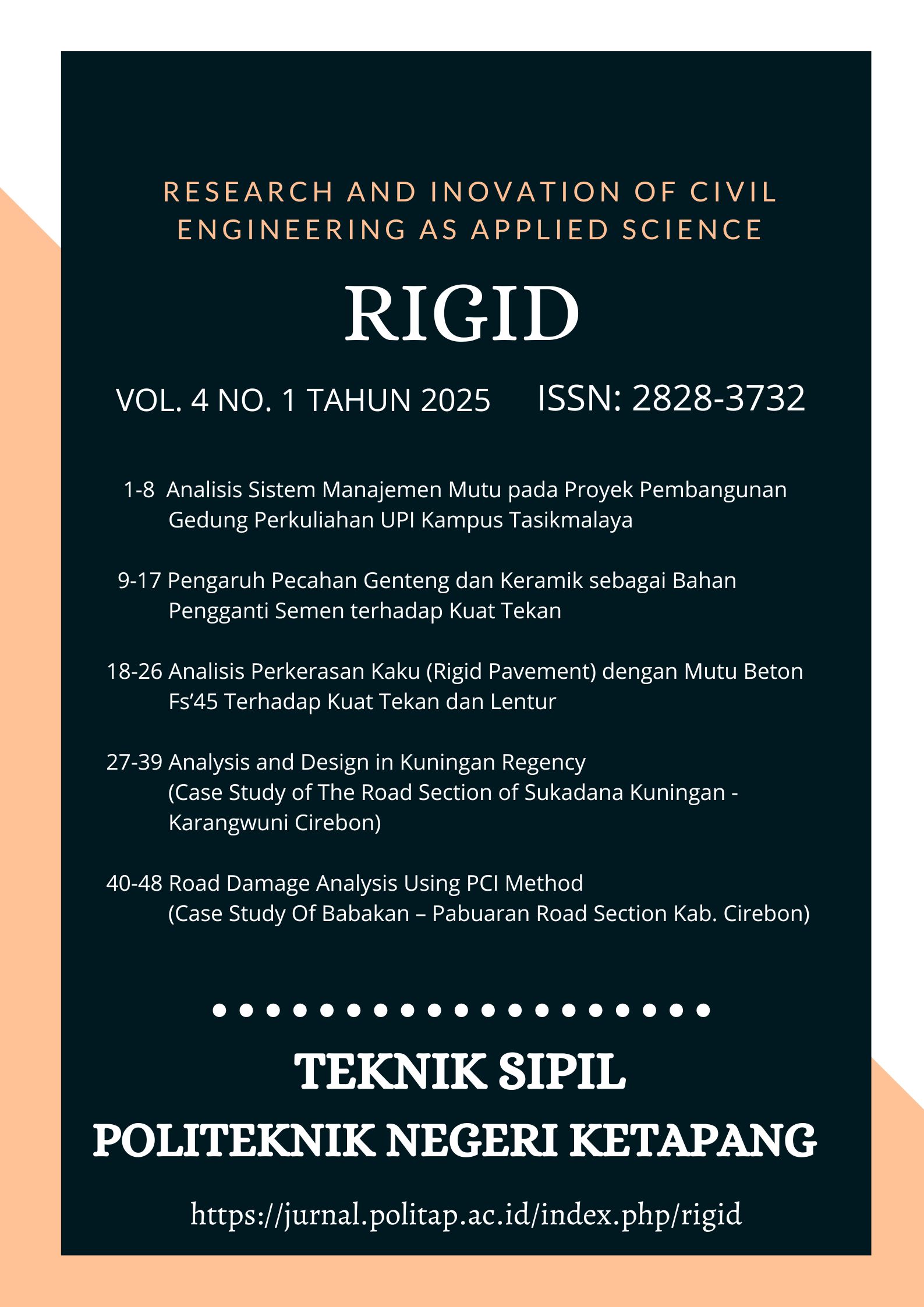Analysis of Rigid Pavement with Fs'45 Concrete Quality against Compressive and Flexural Strengths
Case Study: Reconstruction of Baros-Petir Road Section
DOI:
https://doi.org/10.58466/rigid.v4i1.1726Keywords:
Rigid Pavement, FS 45 Concrete, Compressive Strength, Flexural StrengthAbstract
This study aims to analyze the use of FS 45-grade concrete in rigid pavement for the reconstruction of the Baros-Petir Road. FS 45 concrete, with a minimum compressive strength of 45 MPa and flexural strength of 5–6 MPa, is designed to withstand heavy traffic loads, particularly from vehicles such as trucks. Testing involved the analysis of compressive and flexural strength using cylindrical samples (150 mm in diameter and 300 mm in height) and beam samples (150 mm x 150 mm x 600 mm) at 7 and 28 days. The concrete mixing process followed a Design Mix Formula, ensuring optimal material proportions and strength. Results revealed that FS 45 concrete achieved an average compressive strength of 42.81 MPa and an average flexural strength of 5.5 MPa, meeting the minimum quality standards of 39.7 MPa and 4.4 MPa, respectively. The concrete demonstrated excellent durability against heavy traffic loads, enhanced the pavement's service life, and reduced long-term maintenance costs. Factors such as subgrade conditions, drainage systems, and construction processes were identified as critical elements for successful rigid pavement implementation. This research contributes significantly to improving transportation infrastructure, offering a more durable and efficient solution, particularly for roads with high traffic intensity.
References
A. Hamid and H. Wildan, “Perencanaan Perkerasan Kaku (Rigid Pavement) Untuk Peningkatan Ruas Jalan Brebes –Jatibarang Kabupaten Brebes,” Infratech Build. J., vol. 1, no. 1, pp. 1–10, 2020.
A. K. Fauzi, “Perencanaan Perkerasan Kaku dengan Beton Precast sebagai Alternatif Percepatan Konstruksi Perkerasan Jalan,” Kurva S J. Mhs., vol. 1, no. 1, pp. 2099–2112, 2020.
U. Saepudin, G. Hartati, and S. Nur Bakri, “Analisis Kuat Tekan Dan Kuat Lentur Beton Berserat Polymeric Sebagai Material Perkerasan Kaku (Rigid Pavement),” J. Media Teknol., vol. 9, no. 1, pp. 88–95, 2022, doi: 10.25157/jmt.v9i1.2788.
I. M. Udiana, A. Saudale, and J. J. Pah, “Analisa Faktor Penyebab Kerusakan Jalan (Studi Kasus Ruas Jalan W.J. Lalamentik Dan Ruas Jalan Gor Flobamora),” J. Tek. Sipil, vol. 3, no. 1, pp. 13–18, 2014.
I. G. A. A. I. Lestari, “Perbandingan Perkerasan Kaku dan Perkerasan Lentur,” J. Transp., vol. 7, no. 1, pp. 128–134, 2013, [Online]. Available: http://unmasmataram.ac.id/wp/wp-content/uploads/18.-I-Gusti-Agung-Ayu-Istri-Lestari.pdf
L. Lendra, A. B. P. Gawei, and L. Sintani, “Analisis Konsumsi Energi Dan Emisi Gas Rumah Kaca Pada Pekerjaan Konstruksi Jalan Dengan Perkerasan Lentur Dan Perkerasan Kaku,” J. Reka Lingkung., vol. 10, no. 3, pp. 201–211, 2022, doi: 10.26760/rekalingkungan.v10i2.165-176.
S. Suhendra, “Kajian Hubungan Kuat Lentur Dengan Kuat Tekan Beton,” J. Civronlit Unbari, vol. 2, no. 1, p. 38, 2017, doi: 10.33087/civronlit.v2i1.15.
F. P. Pane, H. Tanudjaja, and R. S. Windah, “Pengujian Kuat Tarik Lentur Beton Dengan Variasi Kuat Tekan Beton,” J. Sipil Statik, vol. 3, no. 5, pp. 313–321, 2015.
D. Y. Prayoga, H. Herman, and I. Farida, “Prioritas Pemeliharaan Jalan Kabupaten Berdasarkan Ketersediaan Alokasi Anggaran,” J. Konstr., vol. 21, no. 2, pp. 281–288, 2023, doi: 10.33364/konstruksi/v.21-2.1550.
H. Kristyanto, N. Nurokhman, and D. Naufali, “Review Mutu Lapisan Beton Fs 45 Pada Ruas Jalan Kokap Kulonprogo,” CivETech, vol. 5, no. 2, pp. 10–23, 2023, doi: 10.47200/civetech.v5i2.1895.









